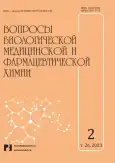Study of extracts dispersed characteristics isolated from Lycium barbarum L. fruts: prospects for pharmaceutical application
- Authors: Tupa B.1, Uspenskaya E.V.1
-
Affiliations:
- Medical Institute, RUDN University
- Issue: Vol 26, No 2 (2023)
- Pages: 23-27
- Section: Pharmaceutical chemistry
- URL: https://journals.eco-vector.com/1560-9596/article/view/248113
- DOI: https://doi.org/10.29296/25877313-2023-02-03
- ID: 248113
Cite item
Abstract
Objective. The State Pharmacopoeia of different countries includes the monographs on Lycium fruits and roots, which have antioxidant activity. However, despite the wide prevalence of plants pharmacotherapy, there are no liquid extracts. This is due to insufficient data on the method of production, the water extracts and tinctures composition, as well as studies of their physico-chemical properties.
Materials and methods. The objects of the study were the Lycium barbarum L. fruits from Western Albania. Extractants used: 30%, 70% and 96% ethanol, purified water (Milli-Q® Integral unit). Extracts were obtained by maceration, according to the Monograph no.1.4.1.0021.15 "Extracts". Studies of the dispersed properties of the isolated colloids – nanoparticle size (d, nm), electrokinetic potential (ζ, mV), polydispersity index (PDI) – were determined by photon correlation spectroscopy method (dynamic light scattering, DLS) and Zetasizer Nano ZS, Malvern, UK.
Results. Samples of Lycium prepared using the technology for water extracts and tinctures showed significant differences in dispersed characteristics, including cumulative (z-average) size, polydispersity index (PDI) and zeta of potential colloidal particles. It is shown that the values of the ζ-potential characterizing the stability of colloids exceed the boundary value of the stability of dispersed systems by 30 mV in water extracts, while in tinctures they have significantly lower values, hence stability. The addition of electrolytes to the LE samples contributed to the structural and mechanical stabilization of dispersed systems (according to Rebinder).
Conclusion. Methods of water extracts and tinctures obtaining and stabilizing, as well as control of their dispersed properties with weekly kinetics, open up new opportunities for the use of promising plant raw materials of Lycium barbarum L. to solve pharmaceutical problems in the search for new drugs.
Full Text
About the authors
Bleona Tupa
Medical Institute, RUDN University
Author for correspondence.
Email: tupableona@gmail.com
Post-graduate Student, Department of Pharmaceutical and Toxicological Chemistry
Russian Federation, MoscowE. V. Uspenskaya
Medical Institute, RUDN University
Email: uspenskaya75@mail.ru
Dr.Sc. (Pharm.), Professor, Department of Pharmaceutical and Toxicological Chemistry
Russian Federation, MoscowReferences
- Liu L., Lao W., Ji Q.S. et al. Lycium barbarum polysaccharides protected human retinal pigment epithelial cells against oxidative stress-induced apoptosis. Int. J. Ophthalmol. 2015; 8: 11–18.
- Boyko N., Bondarev A., Zhilyakova E. et al. Phytopreparations, analysis of the pharmaceutical market of the russian federation. Research Result. Medicine and Pharmacy. 2017; 3: 30–38.
- Monograph AHP – Lycium (Goji) Fruit. The website of the American Herbal Pharmacopoeia available at: https://herbal-ahp.com/collections/frontpage/products/lycium-goji-berry.
- Aziz Z., Ahmad A., Setapar S., et al. Essential Oils: Extraction techniques, pharmaceutical and therapeutic potential – a review. Curr. Drug. Metab. 2018; 19: 1100–1110.
- Fang C., Ko H., Yang C., et al. Nucleation processes of nanobubbles at a solid/water interface. Sci Rep. 2016; 6: 246–251.
- Клындюк А.И. Поверхностные явления и дисперсные системы. БГТУ. 2011; 317 с. (Klyndjuk A.I. Pover-hnostnye javlenija i dispersnye sistemy. BGTU. 2011; 317 s.)
Supplementary files









